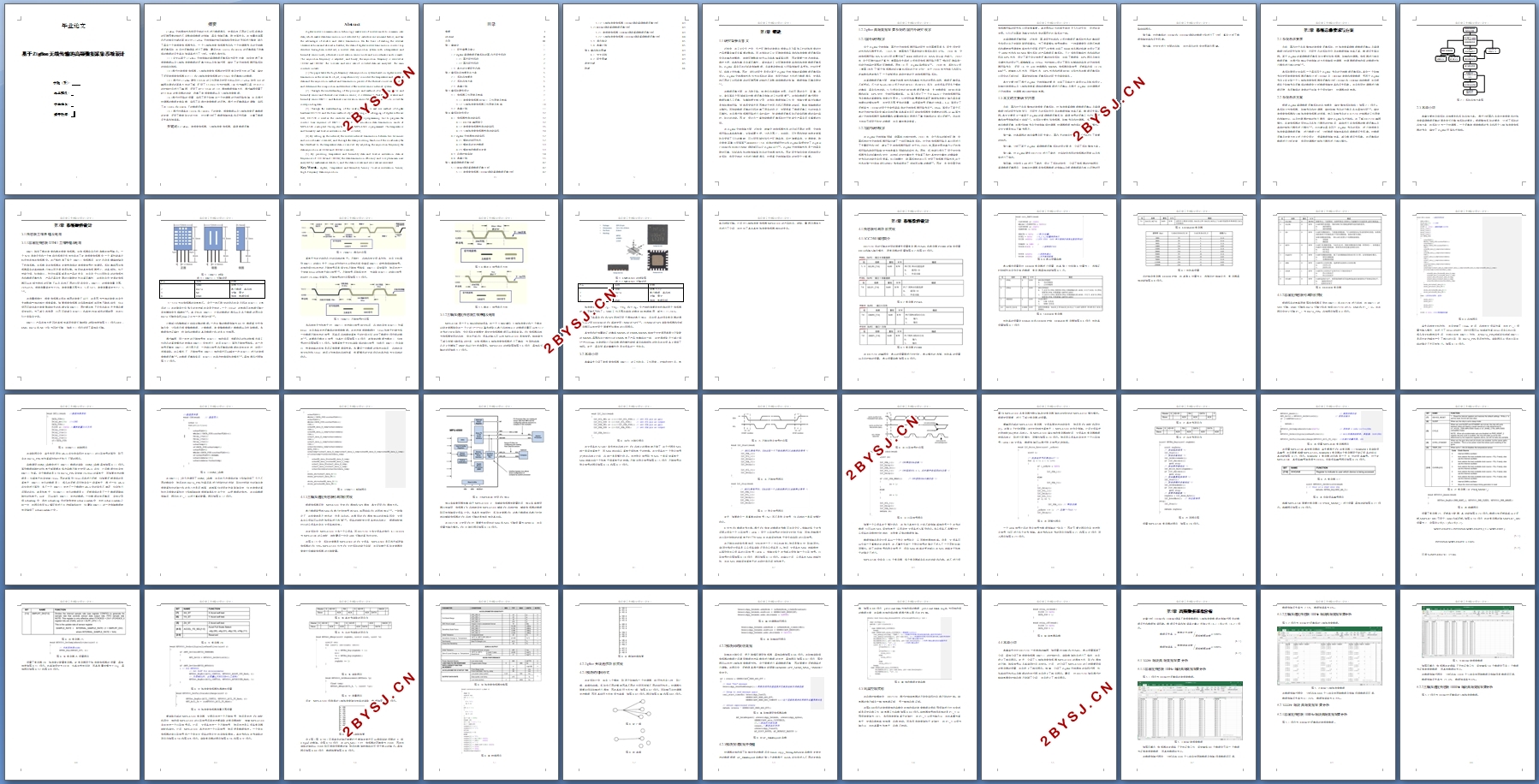基于ZigBee无线传输的高频数据采集系统设计
无需注册登录,支付后按照提示操作即可获取该资料.
基于ZigBee无线传输的高频数据采集系统设计(任务书,开题报告,外文翻译,论文13200字)
摘要
ZigBee无线通信技术利用无线的方式进行数据通讯,使得各种不同的工业现场复杂的环境因素的制约不会影响到数据的传输,具有传输可靠、稳定等优点。在批量阅读国内外的相关文献的基础上对ZigBee无线传输控制回路结构所拥有的资料进行整理,做出了具有一个温湿度传感器节点、一个三轴加速度传感器节点和一个协调器节点的无线数据采集系统,并且对采集频率进行了调整,最后对在100Hz和1000Hz的采集频率下收集到的数据的丢失率与错误率进行了分析。主要内容包括:
(1)论文以基于ZigBee无线传输的高频数据采集系统为研究对象,综合考虑了温湿度数据以及三轴加速度数据的采集方法以及传输过程,确定了此无线传感器网络系统的组成与结构;
(2)通过对温湿度传感器、三轴加速度传感器的使用原理及使用方法的了解,确定了采用温湿度传感器DHT11和三轴加速度传感器MPU-6500来采集相应的数据;
(3)通过对ZigBee硬件CC2530的工作原理及使用方法以及对ZigBee软件IAR的编程与调试的基本方法的了解,采用了CC2530作为控制器、IAR作为编程工具,对DHT11的控制时序进行了编程,采用了MPU-6500的I2C通信数据传输方式,通过编程设置了MPU-6500的寄存器的功能,收集了温湿度数据以及三轴加速度数据;
(4)通过对网络的设置,实现了两个终端与一个协调器的无线网络传输,并且通过协调器的数据处理函数,实现了风扇对温度数据的反馈。通过对采集频率的调整,实现了在100Hz和1000Hz下的数据采集;
(5)通过对频率在100Hz和1000Hz下的温度、湿度数据以及三轴加速度采集数据的处理,采用了数理统计的方法,对主要分析了数据传输效率和丢失现象,计算了数据丢失率和错误率。
关键词:ZigBee;温湿度传感器;三轴加速度传感器;高频数据采集
Abstract
ZigBee wireless communication technology makes use of wireless mode to communicate data, which makes data transmission not restricted by industrial environment factors, and has the advantages of reliable and stable transmission. On the basis of reading the relevant literature at home and abroad in batches, the data of ZigBee wireless transmission control loop structure havingbeen sorted out, a wireless data acquisition system with a temperature and humidity sensor node, a three-axis acceleration sensor node and a coordinator node is made. The acquisition frequency is adjusted., and finally, the acquisition frequency is received at 100Hz and 1000Hz. The loss rate and error rate of collected data are analyzed. The main contents include:
(1)The paper takes the high-frequency data acquisition system based on ZigBee wireless transmission as the research object, comprehensively considers the temperature and humidity data and the acquisition method and transmission process of the three-axis acceleration data, and determines the composition and structure of the wireless sensor network system.
(2) Through the understanding of the principle and method of using temperature and humidity sensor and three-axis acceleration sensor, it is determined that the temperature and humidity sensor DHT11 and three-axis acceleration sensor MPU-6500 are used to collect the corresponding data.
(3) Through the understanding of the working principle and use method of ZigBee hardware CC2530 and the basic method of programming and debugging of ZigBee software IAR, CC2530 is used as the controller and IAR as the programming tool to program the control time sequence of DHT11. The I2C communication data transmission mode of MPU-6500 is adopted. The register function of MPU-6500 is programmed. The temperature and humidity and triaxial acceleration data are collected;
(4) By setting up the network, the wireless network transmission between two terminals and a coordinator is realized, and through the data processing function of the coordinator, the fan's feedback to the temperature data is realized. By adjusting the acquisition frequency, the data acquisition at 100Hz and 1000Hz is realized;
(5) By processing temperature and humidity data and triaxial acceleration data at frequencies of 100 Hz and 1000Hz, the data transmission efficiency and loss phenomena are analyzed by mathematical statistics, and the data loss rate and error rate are calculated.
Key Words:ZigBee; Temperature and Humidity Sensor; Tri-axial Acceleration Sensor; High Frequency Data Acquisition

目录
摘要 I
Abstract II
目录 III
第1章绪论 1
1.1 研究背景及意义 1
1.2 ZigBee高频数据采集系统的国内外研究现状 2
1.2.1国外研究现状 2
1.2.2国内研究现状 2
1.3 本文的主要研究内容 3
第2章系统总体要求与方案 5
2.1 系统总体要求 5
2.2 系统总体方案 5
2.3 本章小结 6
第3章系统硬件设计 7
3.1 传感器工作原理及电路 7
3.1.1温湿度传感器DTH11工作原理及电路 7
3.1.2三轴加速度传感器工作原理及电路 10
3.2 本章小结 11
第4章系统软件设计 32
4.1 传感器检测功能实现 32
4.1.1 CC2530编程简介 32
4.1.2温湿度传感器检测功能实现 35
4.1.3三轴加速度传感器检测功能实现 39
4.2 ZigBee无线通信功能实现 52
4.2.1模块的组网形式 52
4.2.2模块间的发送数据 53
4.2.3模块接收数据并处理 53
4.3 风扇控制实验 54
4.4 本章小结 55
第5章高频数据采集分析 42
5.1 100Hz频段高频数据采集分析 42
5.1.1温湿度传感器100Hz频段高频数据采集分析 42
5.1.2三轴加速度传感器100Hz频段高频数据采集分析 43
5.2 1000Hz频段高频数据采集分析 43
5.2.1温湿度传感器1000Hz频段高频数据采集分析 43
5.2.2三轴加速度传感器1000Hz频段高频数据采集分析 44
5.3 得出结论 45
5.4 本章小结 45
第6章总结与展望 43
6.1 全文总结 43
6.2 研究展望 43
参考文献 45
致谢 46
